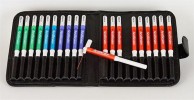Authors
Gómez Molins A, Adami C, Shing H, Monticelli P.
Lab
Dick White Referrals, Six Mile Botton, Cambridgeshire, UK.
Journal
Vet Med Sci.
Abstract
Persistent socket pain is a condition described in humans after enucleation of the eye. This report aims at describing this condition in dogs. A 10-year-old male-neutered crossbreed was presented to the referral veterinary surgeon for enucleation of the right ocular globe. Anaesthesia and surgery were uneventful although during the postoperative period the dog was reluctant to open the mouth and to be explored by the referral veteterinary surgeon. Despite treatment with meloxicam, paracetamol and tramadol, no improvements were observed. Ten weeks after surgery, the dog was referred to the Dick White referrals for further investigations. Ophthalmic examination was normal, though palpation of the wound triggered an avoidance response. Magnetic resonance imaging showed changes compatible with orbital cellulitis. The area of interest was evaluated with the use of the mechanical Von Frey filaments. A response, characterised by sudden turning of the head and attempts to withdraw it, was evoked with filament 4.93 (8.0 g) during stimulation of the periorbital area. After induction of anaesthesia, an ultrasound-guided injection containing levobupivacaine 0.5% and methylprednisolone was performed within the retrobulbar area. Three hours after recovery from anaesthesia, no discomfort was observed during palpation of the area. Re-evaluation was performed with the Von Frey filaments; no response could be evoked during testing with all 20 filaments (from 2.36 to 6.65) applied on either side of the face. The patient was discharged with a course of gabapentin and, 3 weeks after the intervention, the dog showed no clinical signs of pain. Persistent socket pain is an unpleasant sensation at the level of the enucleated orbit, and it should be regarded as a challenging condition to diagnose and treat. The MRI findings appeared to be essential to select the most appropriate interventional treatment. The injection of local anaesthetic and steroid into the retrobulbar space was useful for both confirming the diagnosis and treating pain by reducing the peripheral signalling and decreasing the residual inflammation.
BIOSEB Instruments Used:
Von Frey Filaments (BIO-VF-M)

 Pain - Thermal Allodynia / Hyperalgesia
Pain - Thermal Allodynia / Hyperalgesia Pain - Spontaneous Pain - Postural Deficit
Pain - Spontaneous Pain - Postural Deficit Pain - Mechanical Allodynia / Hyperalgesia
Pain - Mechanical Allodynia / Hyperalgesia Learning/Memory - Attention - Addiction
Learning/Memory - Attention - Addiction Physiology & Respiratory Research
Physiology & Respiratory Research
 Pain
Pain Central Nervous System (CNS)
Central Nervous System (CNS) Neurodegeneration
Neurodegeneration Sensory system
Sensory system Motor control
Motor control Mood Disorders
Mood Disorders Other disorders
Other disorders Muscular system
Muscular system Joints
Joints Metabolism
Metabolism Cross-disciplinary subjects
Cross-disciplinary subjects Happy new year 2025
Happy new year 2025 